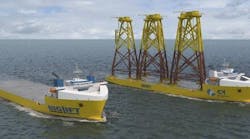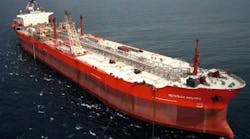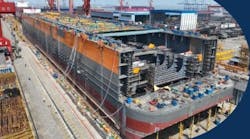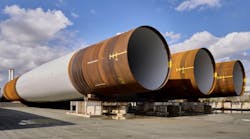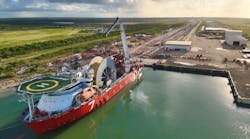Gene Kliewer
Technology Editor, Subsea & Seismic
The waters of Latin America drive the region’s upstream oil and gas business, and the potential for more success suggests the area will continue to draw attention. How the area will develop depends upon the national oil companies. The NOCs in Brazil, Venezuela, and Mexico hold about 90% of all reserves and account for 90% of all production. Even in the smaller arenas of Colombia and Ecuador, the NOCs produce more than half the oil. This reliance on NOCs remains a barrier to operations in Venezuela and Mexico, and to some degree Brazil which is considering new legislation to restrict some areas of operation to Petrobras.
Even without the political climate in Venezuela and the difficulties operating offshore Mexico, and the omen of possible geographic restrictions to exploration and development, Brazil still would be the shining star in Latin America’s upstream oil and gas sky. Barring any dramatic changes in its operating environment, Brazil will continue to increase its position as the hottest spot in Latin America. Production records of more than 2 MMb/d of oil and plans for multiple drilling rigs and FPSO installations, and the lure of export dollars are expected to keep Brazil’s Petrobras moving at its current pace for a long time to come. Add that to the formation of some local operators and the successes by international oil companies off its shores, and Brazil dominates Latin America’s oil business.
Looking broadly, earlier this year Spectrum and the Hamilton Group were planning multi-client 2D seismic surveys plus basin analyses of offshore South America. In an even wider scope, Brazil’s salt-related finds are prompting exploration for similar strata on the African side of the Atlantic. (See story on page 44).
ION Geophysical’s BrasilSPAN regional seismic data acquisition program now has a total of 28,000 km (17,398 mi) of regional seismic data covering Brazil’s southern Santos, Pelotas, and northeastern Equatorial basins with the recent addition of 28,000 km (17,398 mi) of data. This program combined with ION’s CongoSPAN off Angola should be insightful for geoscientists investigating the geologic connections between Brazil and Africa.
Brazil
There is big news on the production side of Brazil’s oil and gas industry. Petrobras says it set a monthly oil production record in Brazil of 2,033,000 b/d in April. This surpassed the previous record by 29,000 b/d. Petrobras also says it set two consecutive daily oil and LNG production records on April 23-24 of 2,081,000 b/d and 2,084,000 b/d, respectively.
The results stem from operations at the platforms offshore Rio de Janeiro and Espirito Santo, especially the connection of new wells to the FPSO Cidade de Vitoria in Golfinho field and new wells on production in Marlim Leste.
In the near future, production is expected to rise further when FPSOsCidade de Santos in Urugua/Tambau and Capixaba in Cachalote/Baleia Franca are counted. Capixaba went onstream in June and ultimately is to connect to nine wells with peak production by year end of 100,000 b/d of oil.
The news items coming out of Brazil are continuing reports of new discoveries, both pre- and sub-salt. As expected, Petroleos Brasiliero (Petrobras) leads this way in drilling. Here are some of Petrobras’ most recent successes:
- Well 6-MRL-199D-RJS in the pre-salt of Campos basin reached TD of 5,000 m (16,404 ft) and in the process found carbonatic reservoirs of the Aptian at 4,460 m (14,633 ft). The well is 4.5 km (2.8 mi) from theP-27 platform which could hasten development.
- Well 6-CRT-43-RJS (Carimbé) found the same Aptian light oil and is thought to be an extension of the Barracuda field. It may be connected to theP-48 platform for production.
- The Tupi appraisal well 3-RJS-666 in pre-salt Santos basin confirmed the original discovery of Tupi in BM-S-11 in 2,115 m (6,939 ft) water depth.
Petrobras is not the only successful driller offshore Brazil. OGX Petróleo e Gás Participações SA, a Brazilian company, reports a number of strikes, too. Among them:
- Well 1-OGX-11D-SPS in BM-S-59 block of Santos basin had gas and condensate in the Santonian section of the Natal some 104 km (65 mi) offshore. Water in the block is 170 m (558 ft) in depth.
- Both wells OGX-6 and OGX-8 in the BM-C-41 block were successful, according to OGX. OGX-6 well on the Etna prospect was drilled to TD of 3,604 m (11,824 ft), with hydrocarbon shows in the carbonate Albian and Aptian sections. It encountered an oil column of around 70 m (229 ft), with 38 m (124 ft) of net pay. Well OGX-8 on the Fuji prospect, drilled to 4,110 m (13,484 ft), encountered a 180-m (591-ft) oil column with approximately 43 m (141 ft) of net pay in carbonate reservoirs, also in the Albian section. OGX-8 is off Rio de Janeiro state in 135 m (410 ft) water depth.
OGX adds that samples and logs indicate a correlation between the Albian reservoirs of OGX-6 (Etna), OGX-3 (Waimea), and OGX-2 (Pipeline). The Etna prospect is 8.5 km (5.3 mi) northeast of the Waimea prospect and appears to be structurally 400 m (1,312 ft) above the Waimea reservoir. OGX estimates recoverable oil volumes at 1.4-2.6 Bbbl for the Pipeline/ Etna accumulation. For the potential Waimea/Fuji structure, the estimate is 600 MM -1.1 Bbbl.
Anadarko Petroleum also finds Brazil productive. A drillstem test at Wahoo-1 in Campos basin deepwater flowed at a rate of 7,500 b/d of oil and 4 MMcf/d of gas. Anadarko was moving 5 mi (8 km) north to spud Wahoo-2.
Field development
The offshore finds are leading to production action. An extended well test from the semisubmersibleSS-11 Atlantic Zephyr in exploratory block BM-S-40 in the Santos basin’s Tiro e Sídon areas is under way for Petrobras. The test program calls for one year of production from both well 1-SPS-56 in Tiro and well 1-SPS-57 in Sídon. Meanwhile, Petrobras says it plans to drill in block BM-2-12 to the east.
Evaluations from nearby Cavalo Marinho, Caravela, and Estrela do Mar fields added to results from the extended test, will determine the future of the Santos basin, Southern Pole discoveries and whether an integrated production system can be supported there.
Illustration of the salt intrusions. The pre-salt is below the salt and the post-salt is above. Courtesy Petrobras.
The Papa Terra project, operated by Petrobras with Chevron as a partner and estimated to cost $5.2 billion to develop, is 70 mi (110 km) offshore in 3,900 ft (1,190 m) of water in block BC-20 of the Campos basin. As it stands now, the project will have the first tension-leg platform ever offshore Brazil. It will connect to an FPSO. Ultimate capacity is to be 140,000 b/d.
J. Ray McDermott holds the contract to build theP-61 tension-leg wellhead platform for Papa Terra. J. Ray’s scope is part of the larger project comprising design, engineering, construction, transportation, installation, and a three-year limited operations contract, that was awarded to FloaTEC Singapore, a joint venture between Keppel FELS and J. Ray.
The TLWP will be built at Keppel FEL’s BrasFELS yard in Angra dos Reis, Brazil. J. Ray will fabricate the tendons, temporary buoyancy modules, and piles at Morgan City, Louisiana. The FloaTEC Singapore joint venture will supply risers, well systems, and tendon components, and J. Ray will install the facility in the Papa Terra field usingDerrick Barge 50. J. Ray will also provide topsides engineering and procurement services.
The project is targeted for completion by mid-2013.
One of the largest new developments to come onstream offshore Brazil is the Shell-operated Parque das Conchas. The Parque das Conchas project, formerly known as BC-10, uses an FPSO with 100,000 b/d of oil and 50 MMcf/d of natural gas production capacity. Shell has a 50% share; partners Petroleo Brasileiro (Petrobras) holds 35% and India’s ONGC Campos holds 15%.
Production comes from the Abalone, Ostra, and Argonauta B-West fields at depths of 950 m to 2,500 m (3,117 ft to 8,202 ft) below the seabed. This first phase involves nine producing wells.
In a technical first, oil and gas are separated on the seabed before electric pumps push the oil upwards from the low-pressure reservoirs to a specially converted production vessel on the surface that stores it for shipping to shore.
With its domestic oil and gas supply growing, Brazil is at the point of considering exports. For example, the BG Group and Petrobras are developing FLNG as an additional option to commercialize the Santos basin pre-salt production. A new FLNG vessel would operate near the planned Santos basin FPSOs. The vessel would process and liquefy the associated natural gas from the pre-salt fields before offloading to LNG ships. The FLNG processing capacity is anticipated to be up to 14 MMcm/d of associated gas.
By developing its reserves with subsea equipment, Petrobras and Brazil have become leaders in application of the technology.
Aker Solutions has signed a $300-million frame agreement with Petrobras to supply 40 vertical subsea trees for its Iara and Guara field developments in the pre-salt Santos basin. Contract party is Aker Solutions do Brasil Ltda.
The full work scope includes engineering and manufacturing of the 40 trees for operations in 2,500 m (8,202 ft) water depth, associated subsea control systems, and 17 tool sets. Consignments will be delivered in phases over the next four years.
Petrobras has awarded FMC Technologies a four-year subsea tree frame agreement. FMC’s scope of supply includes the manufacture of up to 107 subsea trees and related tools for use offshore Brazil in water depths of 6,500 ft (2,000 m). Deliveries are scheduled to begin in 2012.
Petrobras has awarded Nexans a $48-million contract to develop, manufacture, and supply the electro-hydraulic control umbilicals for the Tambau and Urugua fields in the Santos basin. The umbilicals will connect the FPSOCidade de Santos MV20, serving the Tambau and Urugua gas and oil fields, to the subsea manifolds, and then connect the manifolds to the production wells.
Falkland Islands
A small spot with a disproportionate amount of activity, the Falkland Islands continue to see drilling. Rockhopper Exploration has updated the analysis of its Sea Lion oil discovery in the offshore North Falkland basin. According to independent consultants RPS Energy, the field could contain 242 MMbbl of recoverable oil, with significant upside potential.
Well 14/10-2 was drilled in April and May to a depth of 2,744 m (9,002 ft), and following completion of final logging, was suspended for future testing. The well penetrated what is thought to be a regional seal between 2,250 and 2,374 m (7,382 and 7788 ft) subsea. Based on log analysis, well site evaluation of shows and samples, sidewall cores, and wireline formation testing, all sands encountered beneath the regional seal at this location appear to be charged with oil. No oil/water contacts were encountered.
The top oil sand in Sea Lion was encountered at 2,374 m (7,789 ft) subsea, and the base of the lowest oil sand at 2,591 m (8,500 ft) subsea. Rockhopper estimates the total vertical oil column at 217 m (712 ft), with total net pay of 53 m (174 ft) in seven identified pay zones, the thickest around 30 m (98 ft) gross.
Pressure data suggest there may be two separate oil columns, although this will have to be confirmed by the well test. The main Sea Lion fan has a net pay interval of 34.5 m (113 ft). Other underlying sands have total net pay of around 18 m (59 ft), some of which appears to be connected to a Sea Lion lower fan, which had been regarded as a primary prospect. The well also intersected a further 2 m (6.5 ft) of deeper pay.
Oil down to 2,591 m subsea is 116 m (380 ft) beneath the lowest mapped point of the entire Sea Lion fan, which has an aerial extent of over 45 sq km (17 sq mi). There are seismic indications of thicker reservoir compartments elsewhere in the fan.
Rockhopper believes the well has opened a new play fairway in licenses PL032 and PL033.
The play around the Falklands may be set to expand, too. Desire Petroleum has classified its first well in the North Falkland basin as a gas discovery. The Liz well 14/19-1 reached a TD of 3,667 m (12,031 ft), and is currently being plugged and abandoned.
Initial log interpretation suggests that the well encountered 17 m (56 ft) of net hydrocarbon pay at sub-surface depths between 2,961 and 3,031 m (9,714 and 9,944 ft) within a zone of over-pressured, and chiefly sandstone, reservoir. A hydrocarbon sample and formation pressures were recovered from this interval.
Early analysis indicates wet gas, with no apparent water-leg in this interval. Desire adds that further work will be needed to evaluate reservoir quality, to determine the trapping mechanism, and to assess the discovery’s potential.
The well also recovered dry gas in a separate accumulation in a different pressure regime from a deeper interval below 3,400 m (11,155 ft). This suggests that gas pay is present in generally poor quality reservoir. However, there is uncertainty over the rock type and its reservoir potential.
The Liz fan was encountered between 2,540 and 2,568 m (8,333 and 8,425 ft). Desire says that good oil shows were recorded while drilling, but logging and sampling confirmed that this reservoir interval was tight. The company believes the Beth fan was also penetrated between 2,654 and 2,672 m (8,707 and 8,766 ft), again with oil shows in tight reservoir. Further weak oil shows were recorded in conglomeratic zones between 2,706 and 2,932 m (8,878 and 9,619 ft).
Liz was the first in a multi-well, multi-operator campaign offshore the Falkland Islands using the semisubOcean Guardian. Rockhopper will now drill two wells in the North Falkland basin and BHP one in the East Falkland basin before the rig returns to Desire for further drilling later in the year.
Desire says it will use the next three months to evaluate data from the Liz well. These and the results of the Rockhopper wells should assist planning of future well locations.
Other Latin America
Tullow Oil has signed a Heads of Agreement with Staatsolie concerning block 47, a 2,369-sq km (915-sq mi) deepwater exploration license offshoreSuriname.
The signing will allow the two parties to finalize a production sharing contract for the block. Tullow plans to acquire seismic data during 2011 and anticipates drilling wells, as part of its near-term exploration program in the Equatorial Atlantic region of South America. It also has exploration interests offshoreGuyana and French Guiana.
Tullow will operate the license with a 100% interest during the exploration phase. Staatsolie has the option to participate during the development and production phases with a 20% interest.
The Hydrocarbons General Bureau (DGH) ofPeru has approved BPZ Resources application for extended well testing on the first five oil wells on the Corvina field. The company will continue the tests until first commercial production, currently set for May 31, subject to limits on natural gas flared from each well.
Trinidad and Tobago has released the offshore blocks available in its 2010 round of leasing. The tracts are offered under two protocols, one for shallower waters and one for deepwater (1,000 - 3,500 m [3,281 - 11,483 ft]).
The Energy ministry says this year’s lease sale is simplified and shortened compared to prior years, has fewer biddable items, focuses on the work program and share of profit offer, reduces upfront costs, and fixes the bid winner’s financial obligations. The biggest difference, the government says, is that the tax system was not attractive to bidders and the new system will be more like a production sharing contract.
Follow-up drilling to the late 2009 gas discovery at Perla, offshoreVenezuela, confirms the discovery as “one of the most significant in recent years and the largest ever in Venezuela,” according to Eni. The second shallow water Gulf of Venezuela well, Perla 2, exceeded expectations and has increased Eni’s initial reserves estimation by 30%.
Perla 2, in 60 m (198 ft) of water, found 260 m (840 ft) of net pay in a carbonate sequence with good reservoir characteristics. Production testing flowed 50 MMcf/d plus 1,500 b/d of condensate. Eni says normalized production per well should be more than 70 MMcf/d and 2,000 b/d of condensate.
The Cardon IV block is a joint operation of Eni and Repsol, each with 50% interest. Petroles de Venezuela, the state oil company, has 35% back-in rights it can exercise in the development phase. •



